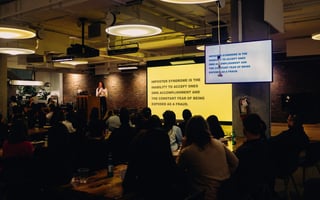How can you deliver a compelling presentation?
There's plenty to think about when asked to give a presentation.
You need to consider the presentation's purpose, the key message you want to get across, how you can grab the audience's interest from the start and ensure they remain engaged, your body language, and how you will deal with audience questions.
The thought of giving a presentation also makes many presenters nervous. So, another important consideration is how you will remain calm.
But what about your presentation structure?
This is easy to overlook.
But a solid structure is crucial.
A presentation that doesn’t flow properly will ensure your audience members feel lost.
When that happens, they switch off.
And the opportunity to get your important points across crumbles, along with the audience's attention.
The presentation structure basics
Before we explore some of the different structures, there are a few presentation basics to consider that could impact which one you choose.
Audience: Who are you talking to? Is it an internal presentation? Are you talking to existing customers? Potential new customers? An industry group?
Aim: What do you want people to do after you present to them? How do you want them to feel?
Format: Are you presenting face-to-face or remotely through Zoom or Teams? If it is face-to-face, is it in a big venue or a small meeting room?
Let's look at some different ways you can structure your presentation
There are many different presentation structures and theories about which ones work best.
Here are a few different ways to structure presentations you could consider:
Logical structure
This is a good starting point as it is the most common structure and is one you will recognise.
It also has a natural flow.
Essentially, you have an introduction where you explain the issues and challenges you will explore and the purpose of the presentation.
You then move to the main body where you get to your main idea and key message and support it with examples and stories.
And finally, you have a conclusion, where you reiterate that message and show how you tackled the aim set out at the beginning.
The problem-solution structure
This is another popular structure.
You begin by giving an overview of the problem. Then go into it in more detail, again using stories and examples to bring it to life.
And finally, you offer the solution, clearly explaining to your audience how it will help them.
The logical order of this structure ends with a clear call to action for the audience – something relevant to the solution.
The story structure
If you have been on one of our presentation skills training courses, you will know we stress the importance of storytelling in public speaking.
Stories are a crucial part of a good presentation and can help speakers stand out.
But stories can also create a good structure. You could base your whole presentation on the classic story structure.
Here, you begin by briefly introducing the situation to the audience, bringing it to life with some description. Then the story progresses with the introduction of a 'hero' – perhaps your organisation’s new product, service or new abilities and skills you are looking to develop among your workforce.
And because every good story has a twist, you add a complication that needs to be overcome. For example, your main competitor has just introduced something similar or maybe a cheaper version of your product.
The story ends with you showing how you can overcome that complication.
The demonstration structure
This is a three-part structure that was used by Steve Jobs.
It works well when you have a new product to demonstrate.
You begin by discussing what the product does, why it is needed and how it will help people.
Then, if possible, you show it doing what you have just set out.
And you finish by hinting at all the other things it could do, to leave the audience wanting more.
The opportunity-benefits-numbers (OBN) structure
Short on time?
This could be the right structure for you. It offers the opportunity to get your key points across in the shortest time.
Here, you begin by outlining the opportunity. To give you an example, let's take you inside our world and say there is a growing demand for online training courses.
Then you move to what the audience could gain from this opportunity. So, if we stick with our example, that could be the ability for a company to train all its staff without needing to hire a venue or have delegates travel across the country.
And then you introduce the numbers that support those benefits. So, we could look at figures that show the demand for online courses, for example. Or maybe statistics on how people like to learn or the cost efficiencies.
A simple but effective structure. But be careful. The more key points and ideas you try to cram in, the less effective it will become.
The Pyramid Principle structure
This is another structure that is all about getting to the main point.
You begin with the conclusion or key message.
Then the presentation progresses to the supporting argument.
And the detailed supporting facts and data come at the end.
It is similar to the inverted pyramid approach most news stories are based on, which we highlight during our writing skills training courses.
And it is great for impatient audiences who want to know the solution before they fully understand the scale of the problem.
The explanation structure
This is one of the best ways to structure a presentation for sharing new knowledge, ideas or processes.
It begins with an overview of the current situation and where you want to get to or how you want to improve.
Then you outline the map or plan for getting to that outcome.
Once that is clear, you move to your first point on how you will reach that goal.
Then move on to what needs to happen after that initial step.
The next stage is to encourage the audience members to reflect on the current situation and what they have learnt about what needs to happen to achieve the ambition.
And then you reach the finish where you can provide a quick summary and invite questions.
Should you structure your presentation like a TED talk?
TED talks can be a good source of inspiration for presentations.
What structure works well on them?
Well, its Ted Talk speaker guide, says there are "many theories on the best structure of a great presentation".
But it also highlights one structure it says it has found "works particularly well".
It says:
-
Start by making your audience care, using a relatable example or an intriguing idea.
-
Explain your idea clearly and with conviction.
-
Describe your evidence and how and why your idea could be implemented.
-
End by addressing how your idea could affect your audience if they were to accept it.
The guide includes another excellent presentation structure tip.
It says: "Your structure should be invisible to the audience. In other words, don’t talk about how you’re going to talk about your topic – just talk about it."
What else do you need to know?
Getting your structure right is vital. But there are other factors in delivering a presentation your audience will follow, and that grab their attention.
Here are a few helpful tips from our presentation skills training courses.
Start strongly
Whatever structure you opt for, you need to start strongly. Your audience will form an almost instant impression of you.
You need to get the audience engaged straight away.
Tell them something unexpected. Share a story or anecdote. Ask the audience a question. Or invite them to imagine a particular scenario.
Storytelling
No matter how well-structured your presentation is, your main message needs supporting evidence.
Facts and figures work well. But there is no substitute for stories.
Storytelling helps create credibility and build rapport - it enables speakers to find common ground with their audience.
It captures attention, entertains and keeps people engaged. It also evokes emotions - vital for persuading and influencing.
And stories are memorable. They can stay with people and impact what they think.
The best stories are human ones. People want to hear about other people, not corporate strategy, management vision or process.
Slides
Slides can offer visual assistance and help a presenter get their key points across.
But there can be too much emphasis on them.
During our presentation skills training courses, we stress that less is more with sides.
Focus them on the main points you want the audience to take away.
Avoid text-heavy slides. Who comes to a presentation to read slides containing paragraphs of text?
Opt for slides that show one point, the odd headline statistic or tagline, which will support and underline your message.
The big finish
The conclusion can often be a part of presenting that people overlook.
But how you bring your presentation to a close requires thought.
A weak ending could undo your good work and leave your audience feeling uninspired or unclear about what you want them to do.
Lose the dull 'thank you' slide.
Instead, consider providing a summary of your main points, repeat something you addressed at the beginning or make it clear to the audience what you want them to do next.
Many presenters answer questions from the audience at this point. You could stand out from most presentations by asking the audience questions instead.
Need more help?
Whether you think you need more assistance structuring presentations or believe your overall presentation skills could do with a boost, we've got you covered.
Speak to us now about your presentation training needs.
Media First are leading media and communication skills training specialists with more than 35 years of experience.
We have a team of trainers, each with decades of experience working as journalists, presenters, communications and leadership coaches, and media trainers.
Discover more about our presentation skills training.




